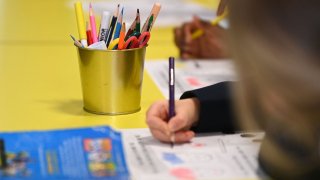
Student scores on Pennsylvania standardized tests fell sharply last year in most categories, although state education officials cautioned the numbers were so distorted by pandemic conditions that they are of limited use for comparison to previous years — particularly regarding statewide trends.
The Education Department on Friday released results of the Pennsylvania System of School Assessment exams for grades three to eight that showed broad declines in both math and English language arts. The Keystone Exams that assess algebra, literature and biology for high school students had more mixed results.
The Keystone exam participation at the high school level was so low, said Brian Campbell, director of the Bureau of Curriculum, Assessment and Instruction, that some smaller schools did not obtain sufficient data to calculate results and publish them without violating confidentiality of individual students’ results.
The Keystone literature exam, typically administered to 10th graders, was taken by just 9% of students, which was partly the result of the decision made early in the pandemic to not administer Keystones at all in 2019-20.
Get top local stories in Philly delivered to you every morning. Sign up for NBC Philadelphia's News Headlines newsletter.
For the Pennsylvania System of School Assessment exams in grades three to eight, where participation was down about one-fourth to one-third, English scores were down 3.5% to 7%, depending on the grade; and math fell 7% to 11%. In science, scores for fourth graders were down about 2%, for eighth graders about 7%.
Scores were higher where participation was higher, Campbell said.
Sherri Smith, the deputy secretary for elementary and secondary education, said that parents and individual schools will likely find the test results useful, but that the drop in the number of test takers across the state makes aggregate numbers unreliable for comparative purposes.
“I think at a state level, on a broad level, it’s hard for us to draw any kind of conclusions, based on all the metrics that changed,” Smith said.
Keystone results for literature were down about 21%, while biology went up slightly and algebra results were level — which Smith said is another indication that 2021 was an anomaly.
Standardized test scores across the country have had substantial declines during the ongoing pandemic, said Scott Marion, executive director of the Center for Assessment in Dover, New Hampshire.
Marion compares the drop-off to missing a half-year of instruction. Results were particularly alarming for students who spent a year learning remotely, according to an analysis of 2021 test scores by his organization.
“The kinds of losses, if you will, that we're talking about, are not made up in a year,” Marion said. “We hope they can be made up in two years — but two years of intensive effort.”
In a normal year, the tests are taken in April and May and released in September and October. But in 2021 the test-taking period was extended through September, under a waiver from the U.S. Department of Education. That in turn delayed the results that were released Friday.
Republican state lawmakers had pressured the Education Department to produce the results, with House Speaker Bryan Cutler, of Lancaster, and Education Committee Chairman Curt Sonney, of Erie, telling Education Secretary Noe Ortega in a Feb. 18 letter that the information was needed to help determine education spending and policy.
Cutler issued a statement after the scores were released that described Pennsylvania students’ learning loss as “immense and very real.”
“The pressure is now on teachers, administrators, parents and other school leaders to work together with policymakers to solve this crisis and to close the gaps,” Cutler said.
Participation in statewide testing, which in a normal year is about 99%, fell to about 71%, a drop-off the department attributed to several factors, including pandemic-driven school staffing outages, transportation problems and building closures.

